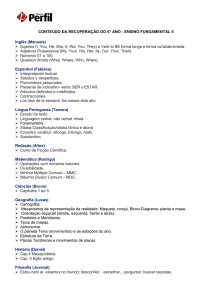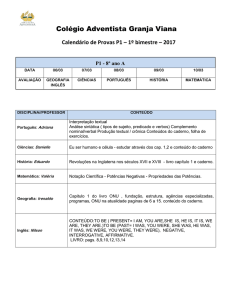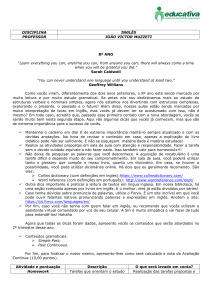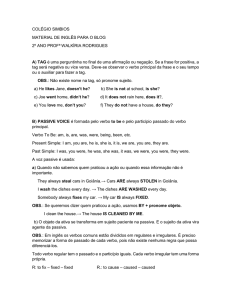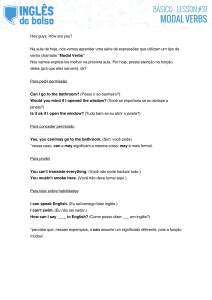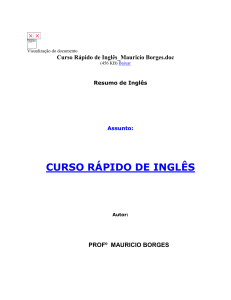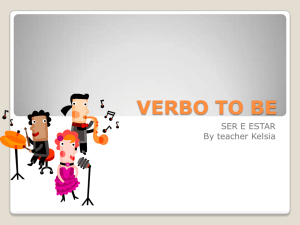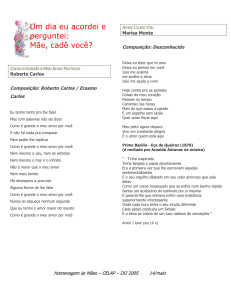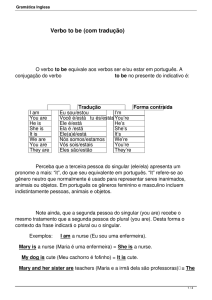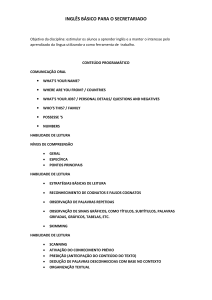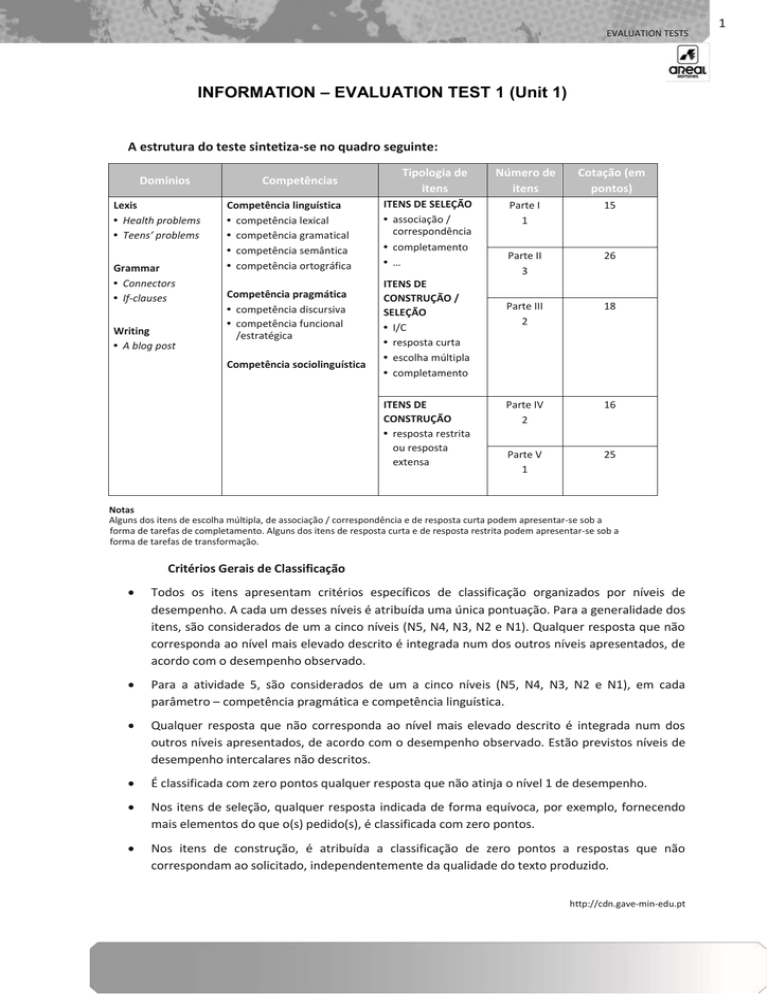
EVALUATION TESTS
INFORMATION – EVALUATION TEST 1 (Unit 1)
A estrutura do teste sintetiza-se no quadro seguinte:
Domínios
Lexis
• Health problems
• Teens’ problems
Grammar
• Connectors
• If-clauses
Writing
• A blog post
Competências
Competência linguística
• competência lexical
• competência gramatical
• competência semântica
• competência ortográfica
Competência pragmática
• competência discursiva
• competência funcional
/estratégica
Competência sociolinguística
Tipologia de
itens
ITENS DE SELEÇÃO
• associação /
correspondência
• completamento
• …
ITENS DE
CONSTRUÇÃO /
SELEÇÃO
• I/C
• resposta curta
• escolha múltipla
• completamento
ITENS DE
CONSTRUÇÃO
• resposta restrita
ou resposta
extensa
Número de
itens
Cotação (em
pontos)
Parte I
1
15
Parte II
3
26
Parte III
2
18
Parte IV
2
16
Parte V
1
25
Notas
Alguns dos itens de escolha múltipla, de associação / correspondência e de resposta curta podem apresentar-se sob a
forma de tarefas de completamento. Alguns dos itens de resposta curta e de resposta restrita podem apresentar-se sob a
forma de tarefas de transformação.
Critérios Gerais de Classificação
Todos os itens apresentam critérios específicos de classificação organizados por níveis de
desempenho. A cada um desses níveis é atribuída uma única pontuação. Para a generalidade dos
itens, são considerados de um a cinco níveis (N5, N4, N3, N2 e N1). Qualquer resposta que não
corresponda ao nível mais elevado descrito é integrada num dos outros níveis apresentados, de
acordo com o desempenho observado.
Para a atividade 5, são considerados de um a cinco níveis (N5, N4, N3, N2 e N1), em cada
parâmetro – competência pragmática e competência linguística.
Qualquer resposta que não corresponda ao nível mais elevado descrito é integrada num dos
outros níveis apresentados, de acordo com o desempenho observado. Estão previstos níveis de
desempenho intercalares não descritos.
É classificada com zero pontos qualquer resposta que não atinja o nível 1 de desempenho.
Nos itens de seleção, qualquer resposta indicada de forma equívoca, por exemplo, fornecendo
mais elementos do que o(s) pedido(s), é classificada com zero pontos.
Nos itens de construção, é atribuída a classificação de zero pontos a respostas que não
correspondam ao solicitado, independentemente da qualidade do texto produzido.
http://cdn.gave-min-edu.pt
1
2
U DARE 9 – TEACHER’S FILE
EVALUATION TEST 1
Name: ______________________________________________________________ No. _____ Class: _________
Date: ____/____/____
Evaluation: __________________________ Teacher: ____________________________
PART I
1
How do you describe a happy and healthy teenager? Write about 30 words.
___________________________________________________________________________
___________________________________________________________________________
PART II
Read the text.
Teenagers and self-esteem
5
10
15
20
25
Are you putting yourself down? If so, you’re not alone. As a teen,
you’re going through lots of changes in your body. And, as your body
changes, so does your image of yourself. It’s not always easy to like
every part of your looks, but when you get stuck on the negatives 5 it
can really bring down your self-esteem.
What influences a person’s self-esteem?
Puberty and development
Some people struggle with their self-esteem and body image when
they begin puberty because it’s a time when the body goes through
many changes. These changes, combined with wanting to feel accepted
by our friends, means it can be tempting to compare ourselves with
others. The trouble with that is, not everyone grows or develops at the
same time or in the same way.
Media images and other outside influences
Our tweens and early teens are a time when we become more aware
of celebrities and media images — as well as how other kids look and how we fit in. We might start to
compare ourselves with other people or media images (“ideals” that are frequently airbrushed). All of this
can affect how we feel about ourselves and our bodies even as we grow into our teens.
Families and school
Family life can sometimes influence our body image. Some parents or coaches might be too focused on
looking a certain way or “making weight” for a sports team. Family members might struggle with their own
body image or criticise their kids’ looks. This can all influence a person’s self-esteem, especially if they’re
sensitive to people’s comments. People also may experience negative comments and hurtful teasing about
the way they look from classmates and peers.
Healthy self-esteem
If you have a positive body image, you probably like and accept yourself the way you are, even if you don’t
fit some media “ideal”. This healthy attitude allows you to explore other aspects of growing up, such as
developing good friendships, becoming more independent from your parents, and challenging yourself
physically and mentally. Developing these parts of 30 yourself can help boost your self-esteem.
http://teenshealth.org/teen/food_fitness/wellbeing/body_image.html# (abridged and adapted)
EVALUATION TESTS
1
For each question choose the correct answer a), b), c) or d).
1.1. What is the author’s purpose in this text?
a) Compare teenagers with high self-esteem and teenagers with low self-esteem.
b) Explain what influences teenagers’ self-esteem so as to help them improve it.
c) Describe the way teenagers lose their self-esteem.
d) Encourage teenagers to boost their self-esteem.
1.2. What influences teenagers’ body image?
a) Body changes combined with peer pressure, parents and coaches’ comments and media
images awareness.
b) Comparison among peers and strong self-awareness due to the media celebrities.
c) Parents, coaches, friends and celebrities.
d) As the body changes, so does the image of themselves.
1.3. Can teenagers have a healthy self-esteem?
a) Yes, if they fit a media ideal.
b) Yes, if they have good friends and a good family.
c) Yes, if they challenge themselves and develop good relationships.
d) Yes, if they develop a positive body image and accept themselves the way they are.
2
Find antonyms in the text for the following words.
a) Get free (para. 1) ______________________________
b) Excluded (para. 2) _____________________________
c) Indifferent (para. 4) ____________________________
d) Accepting (para. 5) _____________________________
3
Complete the sentences according to the text.
a) When teenagers go through a lot of changes in their bodies ____________________________
_____________________________________________________________________________.
b) Family and school can also influence teens’ body image because _________________________
_____________________________________________________________________________.
c) Having a positive body image _____________________________________________________.
3
4
U DARE 9 – TEACHER’S FILE
PART III
1
Read the text below and choose the correct word for each space.
Where can I go if I need help?
Sometimes (1) _________ self-esteem and body image problems are
too much to handle alone. A few teens may become depressed, and
(2) _________ interest in activities or friends. Some go on to
develop eating or body image (3) _________, and can become
depressed or use alcohol or drugs to escape (4) _________ of low
worth. If you’re feeling this way, it can help to talk to a parent,
coach, religious leader, guidance counsellor, therapist, or friend. A
(5) _________ adult, someone (6) _________ supports you and
doesn’t bring you (7) _________ can help you put your body image
in perspective and give you positive feedback about your body,
your skills, and your abilities. The most important thing is to get
help (8) _________you feel like your body image and self-esteem
are affecting your life.
2
1. A. big
B. low
C. high
D. short
2. A. disappear
B. miss
C. lose
D. forget
3. A. problems
B. disorders
C. harms
D. complaints
4. A. symptoms
B. feelings
C. diseases
D. signs
5. A. trusted
B. trusting
C. known
D. responsible
6. A. what
B. where
C. who
D. which
7. A. down
B. up
C. off
D. away
8. A. while
B. whether
C. until
D. if
Name the teens’ problems referred to in the text above and name two more.
____________________________________________________________________________________
____________________________________________________________________________________
____________________________________________________________________________________
____________________________________________________________________________________
EVALUATION TESTS
PART IV
Use the words in brackets to rewrite the sentences. Follow the example.
Ex.: John had a temperature. He went to work. (even though)
Even though John had a temperature, he went to work.
a) Sarah had got a terrible backache. She continued with her house chores. (however)
________________________________________________________________________
b) George sprained his ankle; he walks on crutches now. (therefore)
________________________________________________________________________
c) You look so pale. You are sick. You are very tired. (either… or) _________________
________________________________________________________________________
Complete the sentences with the verbs in brackets.
a) You’d feel better if you _________________ (do) some exercise.
b) Teens _________________ (have) a higher self-esteem if they didn’t watch so much TV.
c) If I _________________ (not be) so sleepy in the morning, I’d feel better at school.
d) If teens didn’t feel stressed, they _________________ (not skip) meals.
PART V
Blogs written by teens are quite common nowadays. Write a post giving your
opinion about one of the following problems (80-100 words):
• depression
• malnutrition
• bullying
• addictions
Use the following guidelines:
_______________________________________
Write the name of the post
(Example: My opinion about
eating disorders);
_______________________________________
Choose a problem;
_______________________________________
Give an introduction with your
opinion;
_______________________________________
Give reasons
opinion;
for
your
_______________________________________
_______________________________________
_______________________________________
Include examples;
_______________________________________
Write a conclusion.
_______________________________________
5
6
U DARE 9 – TEACHER’S FILE
CRITÉRIOS ESPECÍFICOS DE CLASSIFICAÇÃO
PARTE I
1
PARTE III
Responde à pergunta de forma clara e
15
coerente. Pode escrever com incorreções
linguísticas não impeditivas da compreensão.
Exemplo: A happy and healthy teenager
N3 shouldn’t have any health or psychological
problems, such as eating disorders,
addictions, or depression. They should
practise exercise, eat healthy food and have
a high self-esteem.
N2
10
Responde de forma pouco clara e
N1 incompleta, ainda que globalmente
compreensível.
5
1
2
Escolhe 7 a 8 opções corretas.
N3 Chave: (1) B; (2) C; (3) B; (4) B; (5) A; (6) C;
(7) A; (8) D.
8
N2
5
N1 Escolhe 3 opções corretas.
2
Refere os seis problemas. Pode escrever
com incorreções de grafia e pontuação não
impeditivas da compreensão.
N3 Exemplo: Text – depression; eating
disorders; low self-esteem; addictions.
Other: stress; family problems.
10
N2
7
Refere dois problemas. Pode escrever com
N1 incorreções de grafia e pontuação não
impeditivas da compreensão.
4
PARTE IV
1
PARTE II
1
2
3
N3
Escolhe 3 opções corretas.
Chave: 1.1. b); 1.2. a); 1.3. d).
9
N2 Escolhe 2 opções corretas.
6
N1 Escolhe 1 opção correta.
3
Identifica 3 ou 4 antónimos no texto.
N2 Chave: a) get stuck; b) accepted;
c) sensitive; d) challenging.
8
N1 Identifica 2 antónimos no texto.
4
Completa as 3 frases com correção
9
gramatical de acordo com o texto. Pode
escrever com incorreções de grafia não
impeditivas da compreensão.
Exemplo: a) … they start comparing
N3 themselves with the others; b) … they criticise
the kids’ looks and are focused on looking a
certain way; c) … allows teenagers to develop
good friendships and become more
independent as they like the way they are.
N2
6
Completa 1 frase com correção gramatical.
Pode escrever com incorreções de grafia não
N1
impeditivas da compreensão.
3
2
Escreve as 3 frases com correção gramatical.
Pode escrever com algumas incorreções de
grafia não impeditivas da compreensão.
N3 Chave: a) Sarah had a terrible backache;
however, she…; b) John sprained his ankle;
therefore, he…; c) You are either sick or
very tired.
8
N2
5
Escreve 1 frase com correção gramatical.
Pode escrever com algumas incorreções de
N1
grafia não impeditivas da compreensão.
2
Completa corretamente as 4 formas verbais.
N3 Chave: a) did; b) would have; c) weren’t;
d) wouldn’t skip.
8
N2
5
N1
Completa apenas 1 forma verbal
corretamente.
2
EVALUATION TESTS
PARTE V
Competência Pragmática
1
Escreve um post, respeitando o tema dado,
fornecendo pormenores e destacando
aspetos relevantes. O discurso é claro e
N5
coerente, ainda que com recurso a um
número limitado de mecanismos de coesão.
Respeita os limites de palavras indicados.
15
N4
12
Escreve um post simples, incluindo alguns
9
pormenores relevantes. O discurso é
globalmente claro e coeso, ainda que possam
N3
registar-se incoerências. A articulação das
ideias é geralmente linear. Pode não
respeitar os limites de palavras indicados.
N2
6
Escreve um post simples, abordando o tema
de forma genérica e recorrendo a repetições
e pormenores pouco relevantes. Utiliza
N1
frases elementares, mas estrutura
deficientemente o texto. Pode não respeitar
os limites de palavras indicados.
3
Competência Linguística*
Escreve um post corretamente estruturado.
Utiliza de forma geralmente adequada
vocabulário variado, embora possa ocorrer
pontualmente uma escolha de palavras
menos correta. Revela bom domínio
N5 gramatical, com alguns lapsos, raros e não
sistemáticos. A ortografia é razoavelmente
correta, com erros apenas em vocábulos
menos correntes, em que se pode notar a
influência da língua materna. A pontuação é
adequada.
10
N4
8
Escreve um post simples onde revela
domínio linguístico suficiente para articular
as ideias de forma compreensível e com
pouca ambiguidade. O vocabulário é
relativamente pobre, mas consegue suprir
N3 limitações com recurso a circunlocuções e
outros mecanismos de substituição. O
controlo gramatical é suficiente para
permitir a compreensão do que pretende
comunicar. A ortografia é aceitável e a
pontuação é adequada.
9
N2
4
Escreve um post simples, utilizando padrões
frásicos muito elementares. Emprega
estruturas simples, com tendência a misturar
N1 tempos e a esquecer-se de fazer
concordâncias. Utiliza vocabulário muito
elementar. A pontuação nem sempre é
adequada.
2
*A competência linguística só será avaliada se o aluno
tiver tratado o tema proposto, situando-se o seu texto,
pelo menos, no nível 1 da competência pragmática.
7


